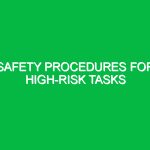In today’s fast-paced world, where industries evolve rapidly, the significance of Workplace Safety Innovation and Technology has never been more pronounced. This concept revolves around the integration of advanced technologies and innovative practices to foster a safer working environment. It plays a crucial role in the Health, Safety, and Environment (HSE) domain, addressing the myriad risks that employees face daily. As organizations strive to maintain compliance and ensure employee safety, the adoption of new technologies becomes a cornerstone of effective risk management.
Understanding Workplace Safety Innovation and Technology
Workplace Safety Innovation and Technology encapsulates a broad spectrum of tools and methodologies designed to enhance the safety and health of employees. This includes everything from sophisticated monitoring systems, data analytics, and artificial intelligence (AI) to wearable technology and virtual reality (VR) training programs. By leveraging these innovations, companies can not only mitigate hazards but also foster a culture of safety awareness among their teams.
For instance, a manufacturing plant in Ohio recently implemented an AI-driven predictive maintenance system. This technology analyzes machine performance data to predict potential failures before they occur, significantly reducing the risk of accidents related to equipment malfunction. Such examples illustrate how innovation and technology can transform workplace safety from a reactive approach to a proactive one.
Identifying Hazards and Risks in the Workplace
While innovation in workplace safety is essential, it is equally important to understand the potential hazards and risks associated with these advancements. The introduction of new technologies can sometimes inadvertently create new risks. Here are some common hazards related to Workplace Safety Innovation and Technology:
1. Cybersecurity Risks
As organizations increasingly rely on digital technologies, the threat of cyber-attacks looms larger than ever. Sensitive employee information, operational data, and safety systems can become targets for malicious attacks. For example, a notable incident involved a healthcare provider’s ransomware attack that compromised patient data and disrupted critical services. Cybersecurity must be a priority in any technological advancement to safeguard against such risks.
2. Ergonomic Hazards
With the rise of advanced machinery and automation, ergonomic hazards can emerge. Employees may face repetitive strain injuries from using high-tech equipment without appropriate training or adjustments. A common scenario involves workers in logistics using automated picking systems that, while efficient, can lead to improper lifting techniques if not monitored properly.
3. Electrical Hazards
The integration of new technology often entails an increase in electrical systems and components. This setup can lead to potential electrical hazards, particularly if the systems are not installed or maintained properly. For instance, a construction company faced serious setbacks when improper wiring in their new safety monitoring system caused electrical failures, putting workers at risk.
4. Dependence on Technology
While technology can enhance safety, over-reliance on it can lead to complacency among workers. If they begin to trust technology implicitly, they may overlook essential safety protocols. A construction site that depended too heavily on automated safety alerts faced a near-miss incident when a worker ignored a manual safety check, relying solely on the system’s warnings.
Safety Precautions and Best Practices
To mitigate these hazards, organizations must implement comprehensive safety precautions and best practices. Here are some actionable strategies:
1. Cybersecurity Training
Conduct regular training sessions focused on cybersecurity awareness. Employees should be educated on recognizing phishing attempts, securing sensitive data, and maintaining strong passwords. Moreover, implementing multi-factor authentication can add an additional layer of security.
2. Ergonomic Assessments
Employers should prioritize ergonomic assessments of workstations, especially when introducing new technologies. This involves evaluating the design of tools and equipment, ensuring they fit the user’s physical needs. Providing adjustable furniture and regular breaks can significantly reduce the risk of musculoskeletal disorders.
3. Comprehensive Electrical Safety Protocols
Electrical safety protocols must be strictly followed. Regular inspections and maintenance of electrical systems can prevent failures. It’s also critical to ensure that all employees are trained to recognize and respond to electrical hazards appropriately.
4. Balancing Technology and Human Oversight
While technology can assist in safety management, maintaining human oversight is essential. Regular drills and manual checks should be conducted to ensure that employees remain engaged with safety protocols. Encouraging a culture of safety where employees feel empowered to voice concerns can further enhance safety practices.
Regulations and Standards Governing Workplace Safety Innovation and Technology
Various regulations and standards govern the adoption of technology in the workplace. These frameworks ensure that innovations enhance safety without compromising employee well-being. Key regulations include:
1. Occupational Safety and Health Administration (OSHA)
OSHA sets and enforces standards for workplace safety in the United States. This includes regulations related to the safe use of technology and equipment, ensuring that innovations comply with established safety norms.
2. National Institute for Occupational Safety and Health (NIOSH)
NIOSH conducts research and makes recommendations to prevent workplace injuries and illnesses. Their guidelines often inform the safe implementation of new technologies in various industries.
3. ISO Standards
The International Organization for Standardization (ISO) provides a framework for organizations to manage safety and health risks. ISO 45001, for example, focuses on occupational health and safety management systems, ensuring that new technologies are integrated responsibly.
The Future of Workplace Safety Innovation and Technology
Looking ahead, the landscape of Workplace Safety Innovation and Technology is set to evolve further. Emerging technologies such as the Internet of Things (IoT), machine learning, and augmented reality (AR) are poised to transform how organizations manage safety. For instance, IoT devices can provide real-time data on workplace conditions, enabling swift responses to potential hazards.
Moreover, companies are increasingly utilizing AR for training purposes, allowing employees to engage in realistic simulations without the risks associated with on-the-job training. These advancements not only enhance safety but also promote a culture of continuous improvement in HSE practices.
Conclusion
Workplace Safety Innovation and Technology represent a vital frontier in enhancing health, safety, and environmental practices. By understanding the potential hazards and implementing effective safety precautions, organizations can harness the power of innovation to create safer workplaces. As technology continues to advance, embracing a proactive approach to safety will be essential in protecting employees and ensuring sustainable operational success.


